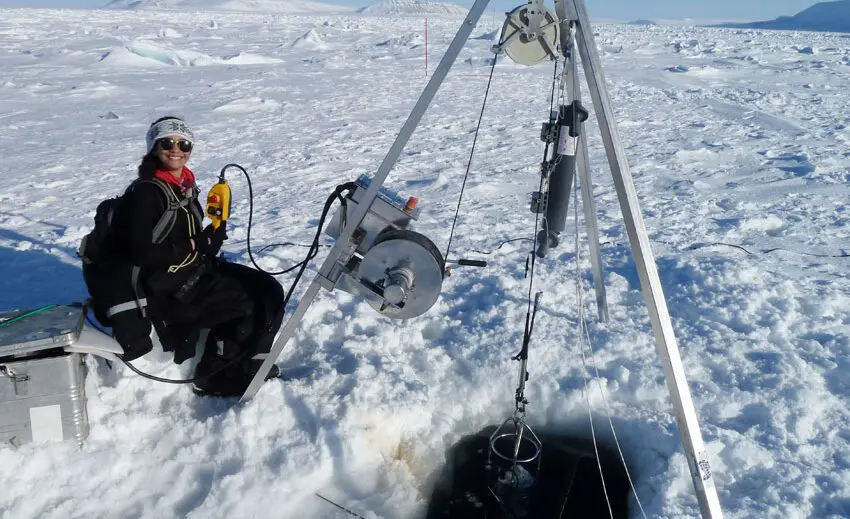AGF-211 Air–Ice–Sea Interaction I (15 ECTS)
ID:
AGF-211
CREDITS:
15 ECTS
APPLICATION DEADLINE:
October 01, 2025
START DATE:
January 07, 2026
END DATE:
June 05, 2026
COURSE PERIOD:
Spring semester. Teaching block 1-3

AGF-211 fieldwork on the sea ice in Palanderfjorden, April 2015. Photo: Ragnheid Skogseth/UNIS.
| Grade: | Letter grade (A through F) |
| Course Cost: | Fieldwork/cruise: Ca. NOK 3000 (10 days x NOK 300 per overnight stay) |
| Course Capacity Min/Max: | 10/20 students |
| Language of instruction: | English |
| Examination support material: | Bilingual dictionary between English and mother tongue |
Course requirements
60 ECTS in mathematics and physics or a related discipline. The applicant must be enrolled in a programme at Bachelor level, or document that the courses are approved into the applicant’s current study programme.
It is also recommended that students have a minimum basic knowledge of earth science and preferably some insight into cryospheric processes. It is an advantage to have basic knowledge in thermodynamics, mechanics, partial differential equations, experience in Matlab or other data analysis.
The course should be combined with AGF-212 Snow and Ice Processes (15 ECTS). The two courses are designed to complement each other.
Academic content
The course gives students an understanding of the processes involved in the interaction between the ocean and the atmosphere in regions totally or partly covered with sea ice. Subjects covered include the thermodynamic aspects of freezing and melting of sea ice, the fine-scale structure of sea ice, the formation and deformation of ice-cover caused by thermodynamic processes and influence of wind, currents and wave action.
The course also covers turbulent boundary layer theory connected with winds and currents in the boundary layers above and below the ice cover, and the processes that provide and influence the energy balance in the ocean-ice-air boundary layer. Energy balance and the effective production of water types in regions with sea ice are discussed with a view to the impact on climate. Fieldwork will take place on sea ice (fjord ice or ice floes) during a scientific cruise with a research vessel. Students make reports from selected field measurements.
Learning outcomes
Upon completing the course, the students will:
Knowledge
- have a wide knowledge of processes controlling the interior structure of sea ice, its growth and decay by thermodynamic and mechanical processes, sea ice movement, large-scale sea ice modelling, and boundary layer theories.
Skills
- be able to develop numerical models related to sea ice growth and decay
- be able to apply turbulence theory in order to calculate heat- and salt fluxes in the under-ice boundary layer
- classify different sea ice types and the corresponding internal sea ice structure through analysing ice core data and through visual observations
- have the ability to handle scientific instruments used in oceanography, meteorology and sea ice research on scientific cruises
- have aquired skills in writing scientific reports based on data collected during fieldwork.
General competences
- have competence in Arctic marine fieldwork operations
- have competence in numerical modelling
- be able to process oceanographic data
- have learned how to write a scientific report
- have learned how to present the results in public
Learning activities
The course extends over a full semester. Initially, students attend one week of compulsory AS-101 Arctic survival and safety training (3 ECTS).
Summary
- Total lecture hours: 60 hours.
- Total seminar hours: 20 hours.
- Field work: 10 days.
The effective learning of air-ice-sea interaction has three essential components:
- Building a knowledge base through classroom lectures, seminars, classroom and laboratory experiments and literature review, with feedback given through formative assessments.
- Fieldwork, where the students engage in research case studies using their knowledge base and theoretical models in the real world. Students are supervised in using different instruments and measuring techniques, and work in cooperative learning groups.
- Writing reports, where the analysis of data is tested against theoretical model, and vice versa. Reports are written under supervision, where feedback and formative / peer assessments are given.
The final examination is oral where we focus on the understanding of the physical processes studied in the course. The students are allowed to defend their report and discuss it in a larger context, connecting it to other students’ reports as well as to theory.
Compulsory learning activities
All compulsory learning activities must be approved in order to sit the exam.
- Fieldwork
- Report review exercise
- Oral presentation of written scientific fieldwork report
Assessment:
- All assessments must be passed in order to pass the course.
- Each assessment is graded, and subsequently combined into a single grade. Partial grades for each assessment will be available.
| Method |
Percentage of final grade
|
| Written fieldwork report | 40% |
| Oral exam | 60% |
Student life


